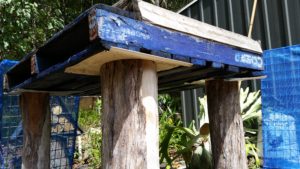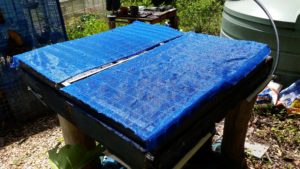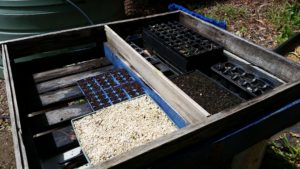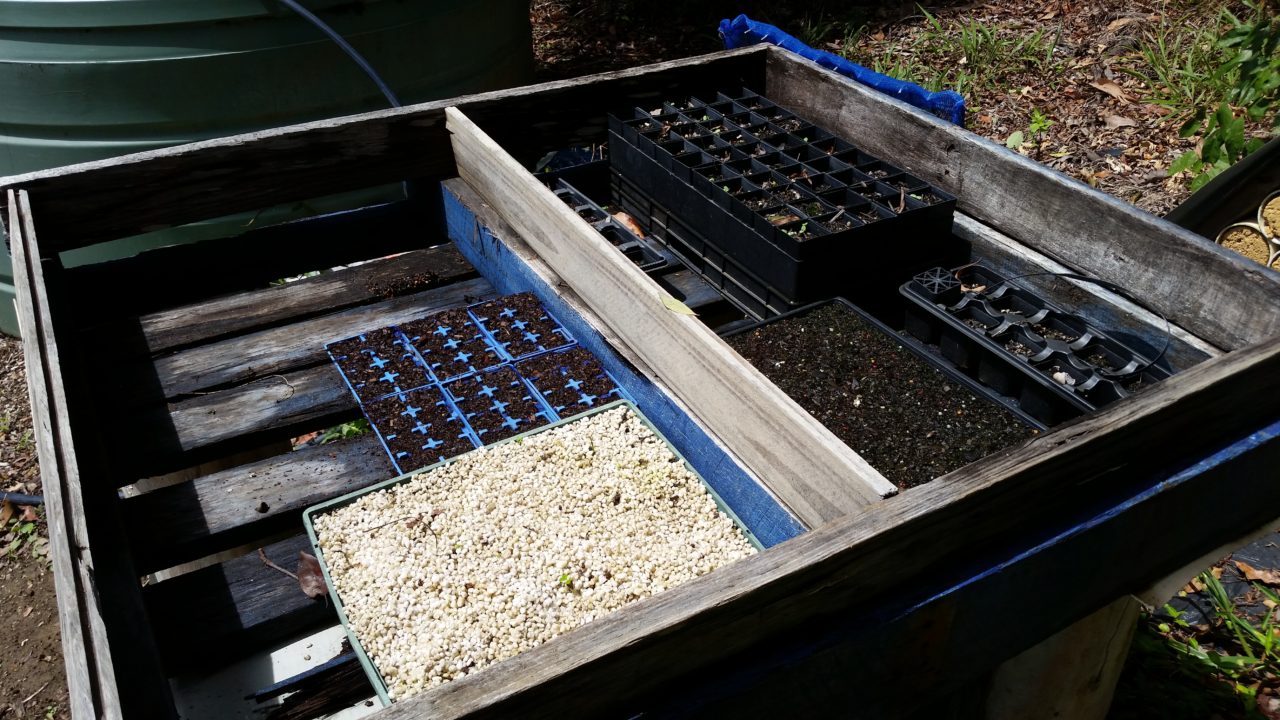Building a dedicated seed raising table has proven very worth while. Just being up and away from pests has hugely increased my success rate in germinating seedlings. It’s not at all fancy, constructed from salvaged bits and pieces, but it’s very effective.
I decided to build a seed raising table after getting seemingly diminishing returns from my sowings, and after trying several formats for seed raising. When we first moved in I was keen to get started in the garden, so just put my punnets and seed trays on a sheltered part of our concrete slab, with some shade cloth anchored over. Not surprisingly, something, probably rodents, ate a good number of the sprouted seeds. I then got the shade house built, with metal mesh shelves, and got a better result, but the seedlings started to disappear again. Finally I built my seed raising table, and my success rate has improved and stayed good.
Seed raising table construction

The table is based on a wooden pallet, and made from bits and pieces that were on hand. It stands on four legs made of a box tree trunk, and it is covered with two shade cloth panels.
The legs are way bigger than necessary, but we always have plenty of fallen timber, so they were easy to saw to size. As they are so big, they were self-standing once sunk in holes and packed around with fill, so they didn’t need cross-bracing. Smaller posts of cut timber would be best either concreted into the holes or braced to make a stable base that won’t fall sideways.
The pallet just sits on the posts, but in an effort to keep rodents out, I capped each post with a piece of roofing metal.

Like the metal rings you used to see on ship mooring ropes, the idea is that anything climbing up a post won’t be able to transition to the next level across the slippery metal. I modified the pallet by cutting out the cross pieces on the side with fewer of them (the under side), thus making a shallow box with a central divider and slatted base. I then built up the rim and central divider with 100 mm boards to make the active area about 200 mm deep.
For the cover I used a couple of pieces of heavy gauge wire fencing with shade cloth sewn on, one cover for each side of the pallet. The shade cloth is 50% because that’s what I had, but I think 25% would work better. The table is somewhat shaded by big trees but does get full sun around the middle of the day.
Evaluation

I have been a bit surprised at how well the table has worked. I have had no interference from nibbling animals at all, and the microclimate of the growth chamber seems perfect for germination. (I should qualify that we have a very mild and humid climate, so the very open nature of the construction is an advantage, but it could be too cold or dry elsewhere.)
I think the shade house shelf I used before was probably pretty active with wildlife at night, and while they don’t bother the mature plants, they are happy to munch any tender seedlings. Anything on the ground is going to be very difficult to protect from mice or crawlies, particularly snails and slugs. The table must just be too hard to bother with. I contemplated putting a screen over the base of the pallet, but that hasn’t been necessary.
Another advantage of the table is that everything is up at bench height for inspection. The shade cloth covers are protective during germination but I tend to remove them during the day once seedlings are up, to stop them getting too leggy from lack of light. The shade cloth also intercepts the rain of leaves from surrounding trees.
In this mild and humid climate the table does pretty well at providing the right microclimate for seedlings. The trays and punnets don’t dry out, although they get a daily watering if it’s hot and dry, and the raised open structure of pallet boards keeps everything well drained and airy. Crucially for my purposes, the shade cloth cover lets in enough light to germinate salvia seeds.

